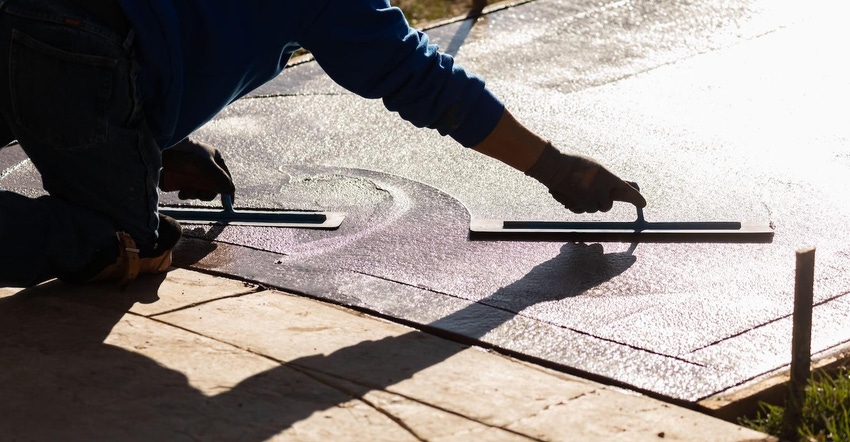A decorative concrete contractor with two decades of experience provided his insights and solutions for dealing with common problems.

Details matter when working with concrete and even more so when working with colored and decorative concrete surfaces. Over the years, Chris Sullivan, who has been installing decorative concrete since the 1990s, has picked up invaluable tips and insights that he shared with fellow industry professionals at a World of Concrete session, titled “Decorative Concrete: Troubleshooting, Techniques, Tips & Trends,” this year in Las Vegas.
Here are some of the insights he provided.
Use acidic cleaners to treat efflorescence
There is often a white, hazy coloration that is produced on the surface of the exposed aggregate after the material gets its first power wash. This hazy coating, known as efflorescence, appears after exposed aggregate meets water, which acts as a trigger. Sullivan said adding an acidic cleaner or a nonacidic surface efflorescence treatment will help get rid of the white haze, but he advised: “You need to seal that. Penetrating sealers are recommended, something that locks that surface out is really the way to go for best results.”
He also warned that sealers can change the color of a finished concrete product but said there are penetrating sealers that have no impact, which might be preferable depending on what your client is looking for.
Stay consistent with materials
There are variations between suppliers, even with the same types of concrete, but installers can control that by staying consistent with products throughout a job, Sullivan said. For example, he said differences between cement suppliers could be minor or significant because, often times, despite being the same type of cement, suppliers will produce from different limestone sources.
“You do not want to change suppliers in the middle of a job, specifically if you’re dealing with anything colored or decorative,” Sullivan said.
He said changing suppliers mid job is often a “kiss of death” for projects involving decorative and colored concrete because colors will not react the same way with materials from different vendors.
Test acidic products before use
Testing the reaction that acidic products will have with a concrete surface is highly recommended, according to Sullivan.
“Anytime you use acid you need to be careful (because) that is a permanent reaction,” he said. “You’re destroying the surface; you can’t put that back.”
Sullivan said testing an acidic product’s reaction with a surface in an inconspicuous place can save headache and heartbreak down the road.
Avoid nonbreathable membrane plastics
Nonbreathable membrane plastics can cause curing issues for colored concrete and should be avoided, according to Sullivan. He said that nonbreathable plastic blankets can create leopard skin patterns in colored concrete during curing “because it doesn’t breathe and you create inconsistent curing where the material is touching the surface.”
He also said that inconsistent application of curing compounds, or over-applications, can create white spotting that can ruin a finished product.
Carry a seal or compound tinted to match color
Carrying a curing seal or curing compound to the jobsite that is tinted to match the color you’re applying “is a way to get paid and the way to solve problems,” according to Sullivan.
He said that even if your work ends up with inconsistent color from the pour or the finish, using a curing seal or carrying compound that is tinted to match the color you’re applying will “even it out,” if it is used correctly.
“This is one that’s really amazed me for 20 something years, is how few use this (tip),” he said.
Try these inexpensive ways to clean concrete
Sullivan said the best ways to clean decorative and other concretes are not with expensive chemicals distributed by manufacturers. He said water, salt, vinegar, bleach and baking soda can do the trick.
“If you have those you can literally make oxy (stain removers) yourself,” he said. “You can make a baking soda-salt blend that cleans up a lot of different things.”
Sullivan said a blend involving those compounds could clean cigarette ashes, leaf litter, grass and rubber tire materials. “The nice thing about these materials is they’re all organic,” Sullivan said. “They’re all natural. There are no chemicals. They’re not going to destroy the environment, and they’re also less expensive than buying a lot of premade materials.”
Read more about:
decorative concrete equipment and materialsAbout the Author(s)
You May Also Like




